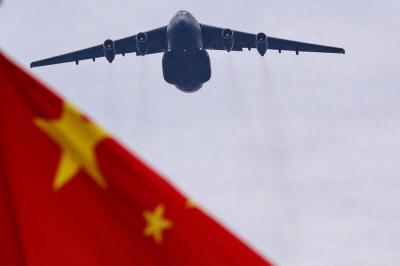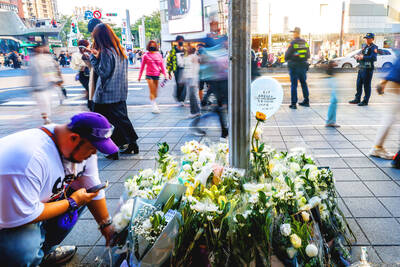Despite the ability of the radar systems deployed by Taiwan’s military to track and engage large numbers of targets simultaneously, Patriot PAC-2 and PAC-3 missile batteries alone would be insufficient to deter China from launching a missile attack, a US specialist wrote.
“Patriot batteries are only one element of a complete missile-defense system,” Ed Ross, a former principal director for security cooperation operations at the Defense Security Cooperation Agency and senior director for China, Taiwan, Hong Kong and Mongolia at the Office of the Undersecretary of Defense for Policy, wrote in the latest issue of the Jamestown Foundation’s China Brief.
“The radars have a range of approximately 170 kilometers, insufficient to detect the majority of PRC [People’s Republic of China] missiles in the boost phase [over Chinese territory],” Ross wrote.
Although PAC-3 missiles were specifically designed for missile defense, he wrote, “unless they are tied into an integrated command, control, communications, computers (C4) system that provides for early warning missile detection, tracking and the prioritization of incoming threats, the number of ballistic missiles they are likely to intercept in a large-scale attack would be greatly reduced.”
Ross, currently a consultant for the defense industry, wrote that despite warming ties between Taipei and Beijing, and even as US President Barack Obama’s administration has shown itself reluctant to agree to arms sales to Taiwan, Taiwan is making steady progress in developing a credible missile defense capability to defense against a missile attack by China.
“To be sure, Taiwan will not have all the critical elements in place for a few more years, but major US Foreign Military Sales to Taiwan necessary for a missile--defense system have been approved by [US] Congress, the Letters of Offer and Acceptance (LOA) have been implemented, and contracts with US defense industries have been signed or soon will be,” he wrote. “All that is required, once Taiwan’s recent purchases have been delivered, for it to complete the system is full integration of Taiwan’s Patriot missile firing batteries with its early warning and command and control systems.”
Defense analysts since 2002 have agreed that Taiwan no longer enjoys air superiority in the Taiwan Strait, a development that has added urgency to the need for a missile defense system, Ross wrote.
“How long would it take for China to overcome Taiwan’s air defenses, what loses China would incur in achieving that goal, and how long would it take the US Pacific Fleet to come to Taiwan’s defense are part of a dynamic deterrence equation that has been shifting in China’s favor for at least the past decade,” he wrote.
Although unlikely under the current detente, missile attacks against a Taiwan that suddenly moves toward de facto independence or drags its feet on entering unification talks would be a relatively cost-free means of coercion or punishment, Ross wrote, as other options — from a blockade to military action against Japan and the US — would give the international community more time to prepare a response.
“A missile attack on Taiwan, in the absence of an adequate missile-defense, however, poses little risk for China beyond the international condemnation that would follow,” he wrote.
“How the international community would react to a ballistic missile attack on Taiwan depends largely on the events leading up to it. From a purely military perspective, however, no aircraft, ships, or PRC military personnel would be at hazard,” Ross wrote, adding that while Taiwan could retaliate with attacks on targets in China, such a response would be limited and the systems and bases Taiwan would use for such attacks would be among the primary targets of a ballistic missile strike by China.
Recent assessments by Taiwanese and US defense establishments put the number of short-range ballistic missiles and cruise missiles China targets at Taiwan at about 1,900.
The key to ensuring minimum deterrence against a missile strike option, Ross wrote, was for missile defenses to be capable of intercepting a large percentage of incoming missiles.
Although many would likely get through, “the ability to intercept 40, 50, or even 60 percent of them would constitute a major deterrent, and should deterrence fail, it would greatly mitigate the effect of such an attack,” thus reducing Beijing’s ability to coerce Taipei and create panic among Taiwanese, he wrote.
Aside from the difficult choices involved in using finite — and expensive — missile defense systems to defend population centers, -government buildings and military installations, Taiwanese authorities will need to ensure that by about 2015, when all US deliveries are completed, its radar sites are fully integrated, which is not the case at present. Key radar systems, such as the long-range early warning Surveillance Radar Program (SRP), will also need better protection, as they would likely be among the first targets of a ballistic missile or anti-radiation missile attack, he wrote. A second SRP would provide the necessary redundancy in case of attack, though budget requests by former president Chen Shui-bian’s (陳水扁) administration for two systems were limited to one.
The extent of the damage to Taiwan’s missile defense capabilities caused by General Lo Hsien-che (羅賢哲), who was arrested last month on suspicion of spying for China, has yet to be fully assessed, although it is believed that Beijing was seeking information about the Po Sheng (“Broad Victory”) program, which incorporates various radar sites involved in such defenses, including the Syun An C4.
“A robust Taiwan missile-defense system makes eminent military and political sense for Taiwan and for the United States. It contributes to peace and stability in the Taiwan Strait and strengthens Taipei’s hand as it strives to improve relations with Beijing,” Ross wrote.
“All that is necessary for Taiwan to achieve the systems full potential is for Taiwan to submit and for the United States to accept a Letter of Request (LOR) and approve a LOA for the complete integration of the Patriot, SRP, and Syun An C4 systems,” he wrote.

Beijing could eventually see a full amphibious invasion of Taiwan as the only "prudent" way to bring about unification, the US Department of Defense said in a newly released annual report to Congress. The Pentagon's "Annual Report to Congress: Military and Security Developments Involving the People's Republic of China 2025," was in many ways similar to last year’s report but reorganized the analysis of the options China has to take over Taiwan. Generally, according to the report, Chinese leaders view the People's Liberation Army's (PLA) capabilities for a Taiwan campaign as improving, but they remain uncertain about its readiness to successfully seize

HORROR STORIES: One victim recounted not realizing they had been stabbed and seeing people bleeding, while another recalled breaking down in tears after fleeing A man on Friday died after he tried to fight the knife-wielding suspect who went on a stabbing spree near two of Taipei’s busiest metro stations, Taipei Mayor Chiang Wan-an (蔣萬安) said. The 57-year-old man, identified by his family name, Yu (余), encountered the suspect at Exit M7 of Taipei Main Station and immediately tried to stop him, but was fatally wounded and later died, Chiang said, calling the incident “heartbreaking.” Yu’s family would receive at least NT$5 million (US$158,584) in compensation through the Taipei Rapid Transit Corp’s (TRTC) insurance coverage, he said after convening an emergency security response meeting yesterday morning. National

Taiwan has overtaken South Korea this year in per capita income for the first time in 23 years, IMF data showed. Per capita income is a nation’s GDP divided by the total population, used to compare average wealth levels across countries. Taiwan also beat Japan this year on per capita income, after surpassing it for the first time last year, US magazine Newsweek reported yesterday. Across Asia, Taiwan ranked fourth for per capita income at US$37,827 this year due to sustained economic growth, the report said. In the top three spots were Singapore, Macau and Hong Kong, it said. South

Taiwan is getting a day off on Christmas for the first time in 25 years. The change comes after opposition parties passed a law earlier this year to add or restore five public holidays, including Constitution Day, which falls on today, Dec. 25. The day marks the 1947 adoption of the constitution of the Republic of China, as the government in Taipei is formally known. Back then the Chinese Nationalist Party (KMT) governed China from Nanjing. When the KMT, now an opposition party in Taiwan, passed the legislation on holidays, it said that they would help “commemorate the history of national development.” That